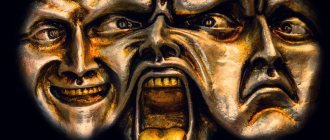Probably everyone has heard such a concept as a “cult of personality”. What first comes to mind when you mention it? Most often, attempts to explain its meaning are based on general information about the most famous dictators, known from history textbooks, and come down to listing some of their features. So what is it really?
When talking about this concept, we are talking about the exaltation or even deification of a person who is at the head of a country or any religious organization (for example, a church). His role in the life of the country and the functions he performs are exaggerated to incredible proportions, and power is considered undeniable or even sacred (depending on ideology and attitude towards religion). The power of the leader is revered as given from above, and in the minds of his people he himself is endowed with certain superhuman abilities, for example, to change the course of history at his own discretion or to directly control the fate of every citizen of the country. Most often, this phenomenon occurs in countries with totalitarian and authoritarian government systems.
What is a cult of personality
We are talking about the exaltation of an individual person, who is a prominent statesman. Those who are interested in what a cult of personality means should give examples of such familiar names as Stalin, Hitler, Mao Zedong, etc. In absolute monarchies, kings and emperors played the role of Gods. They were revered, worshiped and glorified not for specific qualities, but simply for the very fact of their being on the throne.
Under dictatorships and authoritarian regimes, standing at the helm of power was no longer enough. It was necessary to have outstanding qualities that made the ruler worthy of his position. Having powerful propaganda tools in your hands, it is easy to pretend to be someone whom the people want to see as their leader and ruler. Poems were written about such people, epics and lifetime biographies were composed. Their works were studied in educational institutions and monuments were erected to them everywhere.
Religion
No matter how important the awareness of the existence of God is for most of the inhabitants of the Earth, in its pure form, religion is the cult of the Supreme Being, and nothing more. It is the worship of a certain single, independent and omnipotent being that is central to monotheistic religions.
A religious cult is, in addition to worshiping God directly, also endowing a huge number of artifacts and rituals with a certain sacred, higher meaning. Following these very rituals (repentance, communion in Christianity, for example) is one of the main pillars of religion. With their help, you can satisfy the Supreme Being, and for non-compliance, you can anger him.
Religion plays a huge role in human history - so big that it is difficult to overestimate. The world's faiths (Buddhism, Christianity, Islam), in fact, contain all the moral standards of behavior for modern man. Religion thus became higher than a simple cult, that it turned from frightened admiration into a teaching, an attempt to bring human life into a grace-filled order. It is the presence of philosophical impulses that puts religion at a level higher than cult.
What is a full-fledged personality of a citizen?
Speaking about a fully and comprehensively developed person and citizen, we are talking about such a concept as “personal culture”.
Personal culture is, in the first case, the level of human development, his potential, abilities and talents, and in the second, a set of social and political competencies, that is, the ability to:
- to take responsibility;
- participate in the discussion of joint decisions;
- resolve conflict situations without the use of violence;
- participate in making joint decisions regarding the activities of certain social institutions;
- understand cultural and linguistic differences and treat representatives of other nations and cultures with respect.
The formation of a person’s culture occurs in the process of training and education under the influence of his social environment and depends on his individual need for development and improvement.
What if we move away from the sacred?
However, a religious cult is just an item (albeit a huge one) on the list of a person’s worship. A cult does not always carry within itself a higher and divine charge, a desire to explain the world. Our world and history are essentially filled with different varieties of worship.
One of the most important cults in the history of mankind can be called the cult of power. He came to us from the cruel animal world, where the presence of strength is a must for survival.
The strongest (alpha) instantly becomes the main one. Without his permission or knowledge, weaker beings cannot do anything. However, these same betas and gammas follow each other in the same way, creating a simple hierarchical ladder, where the weakest (omega) is obliged to worship the strongest.
A similar animal structure can be clearly seen in schools, where children have not yet learned to control themselves and splash out all the bestiality that is left to us from our ancestors.
Causes
Social psychologists are convinced that the emergence of such phenomena as the cult of personality or idol worship is determined by a certain social environment. It is society that creates the following prerequisites for the emergence of such a cult of personality:
- Political and legal immaturity of people, lack of cohesion and civil society.
- A large number of individuals, the main characteristic of which is socio-psychological infantilism, that is, the inability to predict the consequences of their own actions and bear any responsibility for what they did.
- Low level of culture and education in society (among most of its representatives). Culture and personality give way to the consciousness of the individual.
- Intolerance of dissent in society up to its complete eradication.
- The reasons for the emergence of the cult of personality also include the need for ideological reinforcement of the functioning of the regime.
- The influence of the leader's personal qualities (for example, oratory, charisma and exceptional qualities of intelligence and thinking).
- Manipulation of the consciousness of the masses and its mythologization, that is, the formation of an (artistic) image based on events that actually took place.
All these factors create ideal conditions for the establishment of a totalitarian and authoritarian state system with an exalted leader at its head.
Next stage
However, cult is a developing tradition. At some point in his existence, a person was faced with the fact that there was a thing that was absolutely not subject to his explanations, which did not react in any way to worship and veneration. It was inevitable. This is Death.
From the very birth of human intellect, he was worried about the question of what happens after crossing this line? He couldn't give himself an answer. It was then that the cult of ancestors arose. After all, they, already in the next world, knew what death was. The ancestors who passed on to another world could help a person in worldly affairs, thanks to their wisdom and all-knowledge.
In order to understand the cult of the dead, it is worth familiarizing yourself with the myths of Scandinavia. It was there that, due to the importance of the clan community, ancestor worship was a huge part of local ritual ceremonies.
Purposes of creation
In addition to achieving universal admiration, the creation of such a phenomenon as a cult of personality pursues clear practical goals:
Instill fear in your enemies
The feeling of the presence of the leader's personality everywhere inspires serious fears in everyone who dares to think about a coup.
Appearance of invincibility
There are hardly anyone who would want to compete for power with an infallible god-like being. The main thing is that people perceive the leader as the guarantor of the existence of the state and their own well-being, as an equal to God or his earthly incarnation.
Unlimited power
Only a few of those who believed in the personality of the dictator dare to challenge his decisions or at least somehow express protest.
Creation methods
The path to creating each individual regime certainly has its own characteristics, however, there are a number of general methods that leaders successfully use:
Creating Leader Images
Placing portraits, statues or other images of the dictator in crowded places. The people should see their leader every day, and the more often the better. Everyone should know who exactly is at the helm.
Assigning titles to a political leader
In addition to the title denoting the position held in the state, dictators often assign to themselves other sonorous epithets that speak of courage, strength, love and their paternal love for their people.
Creation of a state ideology with a sonorous name
Ideology is created in the image and likeness of religion, and the main role in it is, of course, given to the political leader.
Publishing your own books
The population of the country should know what political views its leader has, what ideas come into his head. These works should contain not only political reflections, but also moral and ethical instructions. The publication of fiction books or books with one’s own sayings in a small, convenient format is very popular.
Presence in all news
The media should closely monitor the life of the leader and immediately report to the country any news, even insignificant, with the exception of those carrying negative information. The culture and personality of the leader must be united: artists must be encouraged to create works about the head of state.
Naming objects after a leader
Streets, schools, businesses, squares, cities, airports, awards and even mountain peaks can bear the name of a dictator. It all depends on the imagination of the one who is creating the ideology.
Publishing unusual laws
The purpose of such actions is to show the people who exactly makes decisions in the state. Laws may seem stupid and meaningless, but they achieve their purpose.
Iraq - Saddam Hussein
Saddam Hussein became the fifth president of Iraq. This happened in 1979. Hussein's rule lasted until 2003. Hussein's main achievement was the close interaction of the military with the work of the government. As a result of Hussein's rule, the country managed to nationalize oil production and gain control over most banks. All these achievements were accompanied by the elimination of opponents and other repressions. According to one version, at least 250,000 people were killed during the entire existence of Saddam Hussein's regime. Hussein's cult of personality ended in 2003 when the US army invaded the state and captured the country's leader.
Examples
Leonid Brezhnev
Doxology addressed to Brezhnev (or "dear comrade Leonid Ilyich") was a hallmark of "developed socialism". This was not a cult, but a tribute to a major leader supported by the nomenklatura dependent on him, included the presentation of an excessive number of government awards to Brezhnev (including the "Order of Victory", which was awarded only to the great commanders of the Second World War, and four Gold Star medals "Hero of the Soviet Union). Portraits of Brezhnev and banners with slogans based on excerpts from his speeches were hung in government agencies. In the last years of his life, a number of works were published under the authorship of Brezhnev: “Small Earth”, “Renaissance” and “Virgin Land”, which were awarded to Brezhnev with the Lenin Prize. However, it is known that they were written in collaboration with a group of writers. The reaction to these phenomena was reflected in a large number of anecdotes. After the death of Brezhnev and other leaders of the USSR, their names appeared (briefly) in geographical names. Thus, the cities of Naberezhnye Chelny, Rybinsk and others were renamed.
Nursultan Nazarbaev
Many politicians and journalists, such as Zhasaral Kuanyshalin and others, note the cult of personality of Nazarbayev. Dosym Satpayev:
Bolat Ryskozha:
According to political scientist Dilyaram Arkin, Nazarbayev’s cult of personality is beginning to spread beyond the borders of Kazakhstan.
The emergence of myth as a cult
As we found out, initially a cult is the worship of natural phenomena (objects) or ancestors. In the second case, a personality already appeared in worship - evil or good, cunning or honest, having its own specific character.
Endowing inanimate objects and even feelings (!) with personal qualities of a person created a myth. A huge pantheon of various gods has appeared, each culture has its own. However, the cult of ancestors did not go away with the appearance of Zeus, Thor, Ra and other various idols.
Its further development is especially noticeable in China. In the Celestial Empire, everything, the most insignificant phenomenon and the most inconspicuous object, according to the inhabitants, has a guardian spirit. The deceased ancestors became them, sometimes replacing each other or simply patronizing together. Many famous Chinese rulers, scientists and officials “remained” on earth after death, helping ordinary people and protecting rivers, houses, settlements, light and rice fields.
Manifestations of the cult of personality
Stalin began to violate the party's statutory requirements, which was reflected in the irregular convening of party congresses and plenums of the Central Committee, the curtailment of the work of the Politburo of the Central Committee as a collective body of leadership, the violation of internal party democracy in the form of the replacement of elections to party bodies with co-optation, etc. Even in the difficult conditions of foreign military intervention and the civil war, in the first 6 years after October (1918-23), under Lenin, 6 all-party congresses, 5 conferences, and 79 plenums of the Party Central Committee took place. In the first 10 years after Lenin’s death (1924–33), 4 party congresses, 5 conferences, and 43 plenums of the Central Committee took place, mostly devoted to the fight against oppositions and deviations. But over the next 20 years (1934-53), only 3 party congresses and one conference were held, and the interval between the XVIII and XIX congresses was 13 years. Over two decades, only 23 plenums of the Central Committee were convened. In 1941, 1942, 1943, 1945, 1946, 1948, 1950 and 1951 there was not a single plenum of the Central Committee.
By violating Lenin’s “Testament,” Stalin placed himself above the party’s Central Committee, got out of its control, and protected himself from criticism. Stalin methodically strengthened the cult of his personality; he attributed to himself excessive services to the party, the successes achieved by the people in the civil war, in the construction of socialism, in the defeat of Hitler's hordes. Monuments to Stalin were erected everywhere. In order to create an aura of Stalin’s infallibility, the history of the party was distorted, the theory of “two leaders” was persistently propagated, the version that Stalin was the very person who, together with Lenin, created the Bolshevik party, developed its theory and tactics.
Mass repression
The punitive-repressive apparatus and the security forces are being strengthened:
— 1924 — The Central Executive Committee of the USSR approved the “Regulations on the rights of the OGPU regarding administrative expulsions and imprisonment in a concentration camp.”
- 1930 - the Directorate of OGPU Camps was formed under the Council of People's Commissars of the USSR, renamed in 1931 the Main Directorate of OGPU Camps (GULAG).
- 1934 - The People's Commissariat of Internal Affairs (NKVD) of the USSR was formed. It included the OGPU in its entirety, transformed into the Main Directorate of State Security.
— Since November 1934, a Special Conference (“Big Three”) was formed under the People’s Commissar of Internal Affairs, which was given the right to administratively send “enemies of the people” into exile or into forced labor camps for up to five years.
— The Secret Department of the NKVD was created, which was engaged in the destruction of political opponents of the authorities who found themselves abroad (in August 1940, Leonid Trotsky was killed in Mexico, many figures of the Comintern and the white movement became victims of the Stalinist regime).
Changes in the system of government institutions in the 1930s. testified to the formation of the foundations of a totalitarian regime with a powerful repressive apparatus.
1928 - “The Shakhty case” served as an impetus for the launch of the fight against “pests” from among the scientific and technical intelligentsia in all sectors of the national economy.
1930 - trial of the Industrial Party; "The Case of Academicians".
Early 1930s - mass repressions against kulaks and “sub-kulak members”. On August 7, 1932, the Central Executive Committee and the Council of People's Commissars of the USSR adopted the law “On the protection of the property of state enterprises, collective farms and cooperation and the strengthening of public (socialist) property” (the “five ears of corn” law), according to which even minor thefts were subject to a long term of imprisonment or execution .
The reason for the deployment of mass repressions in the country was the murder on December 1, 1934 in Leningrad of S. M. Kirov, a member of the Politburo of the Central Committee of the All-Union Communist Party of Bolsheviks, the first secretary of the Leningrad Provincial Committee of the All-Union Communist Party of Bolsheviks. A few hours after this murder, a law was passed introducing a “simplified procedure” for the consideration of cases of terrorist acts and organizations. The strengthening of Stalin's regime of personal power was facilitated by the wave of the “Great Terror”.
The end of December 1934 - a closed trial of members of the so-called Leningrad center.
April 7, 1935 - The resolution of the Central Executive Committee and the Council of People's Commissars ordered that “minors, starting from the age of 12, convicted of committing thefts, causing violence, bodily harm, murder or attempts to murder, should be brought to criminal court with the application of all criminal penalties” , including the death penalty.
1936 - the first of the major trials of the leaders of the intra-party opposition (G. Zinoviev, L. Kamenev, etc.). Prosecutor A. Vyshinsky accused them of the murder of Kirov, of attempts to kill Stalin and overthrow the Soviet regime.
1937 - the second trial, during which another group of leaders of the “Leninist Guard” was convicted. Most of the accused were sentenced to death (G. E. Zinoviev, L. B. Kamenev, G. L. Pyatakov, N. I. Bukharin, A. I. Rykov, etc.). It is significant that the victim of the third Moscow trial was G. G. Yagoda, who headed the NKVD until September 1937, when he was replaced in this post by N. I. Yezhov.
June 1937 - after a one-day trial in a military tribunal, Deputy People's Commissar of Defense M. N. Tukhachevsky and 7 prominent military leaders - heroes of the civil war - were shot. This was only the beginning of large-scale terror, which affected not only the senior, but also the middle and junior command staff of the Red Army. In fact, in 1937-1938. the army and navy were beheaded. Thus, of the five people who were the first to receive the rank of Marshal of the Soviet Union, established in 1935, three were shot (M. N. Tukhachevsky, V. K. Blyukher, A. I. Egorov).
March 1938 - the third trial took place. The former head of government A. Rykov and the “favorite of the party” N. Bukharin were shot.
A wide network of concentration camps is being formed. Mass repressions of the second half of the 1930s. played an important role in strengthening the totalitarian regime and Stalin’s personal power. The terror also had an economic significance: millions of prisoners worked on the construction sites of the first five-year plans, contributing to the economic power of the country.
Turkmenistan – Saparmurat Niyazov
Turkmenistan gained independence after the collapse of the USSR in 1991. 8 years later, in 1999, Saparmurat Niyazov became the lifelong president of Turkmenistan. Attempts by political opponents to remove Saparmurat Niyazov from the presidency were unsuccessful. All opponents were sent to prisons or psychiatric hospitals, and the media glorified the current ruler. Niyazov is also famous for his rather strange prohibitions. For example, he prohibited the showing of ballet and opera on television, and the wearing of long hair and beards by young men. Saparmurat Niyazov also changed the names of months in honor of his family members.
Exposing the cult of personality
Not a single large-scale phenomenon in the life of society is without consequences. After the euphoria of mass delusion comes disappointment and popular repentance. In any nation that has suffered from the cult of personality, sooner or later self-awareness inevitably awakens.
Sobered citizens begin to doubt the correctness of their chosen path and worry about their future. In the depths of slavish obedience and universal conciliation, a clear understanding of the necessary changes arises, the desire to blow up the system from within.
Forced idolatry provokes the emergence of people who take on the role of denouncers of the cult of personality. In the USSR, Nikita Khrushchev assumed this mission. During the 20th Congress of the CPSU, after Stalin’s death, Nikita Sergeevich made a report “On the cult of personality and its consequences.” In it, Stalin’s former comrade-in-arms voiced his opinion about the leader’s rule, pointing to facts proving the guilt of the “father of nations” in the mass crimes against humanity he committed.
Despite the confidentiality of the document exposing the cult of personality, news about it instantly spread throughout all the cities and villages of the Land of the Soviets. It was discussed in every social unit, at every enterprise. This document received a huge response all over the world. True, they decided to officially publish it only 40 years later - in 1989.
At the same time, internal contradictions between supporters of Stalinism and its opponents have not yet been eradicated. So each member of a post-cult society has to independently recognize the overthrow of their former idol from the pedestal. Some have not come to terms with this fact to this day.
Examples in history
- Joseph Stalin
The most famous Soviet leader who created the most severe cult of personality in the history of the USSR. He ruled the country from 1922 to 1953. The reign is characterized by massive repression of dissidents. He passed away while serving as Chairman of the Council of Ministers of the USSR.
- Saddam Hussein
Political leader of Iraq, who headed the country until April 17, 2003. He was revered by the people of Iraq as a builder of schools and hospitals. After losing the war to American forces, he faced numerous charges, including charges of genocide and mass executions. Executed on December 30, 2006.
- Kim Jong Il
Grand Leader of Korea from October 6, 1994 to December 17, 2011. His cult of personality in North Korea is very close to religion. Any negative statements about this leader are still punishable by actual imprisonment. During his reign, North Korea was repeatedly accused of gross violations of international human rights. After the death of the leader, mourning was declared in the country for a period of three years.
- Adolf Gitler
Leader of Nazi Germany from August 2, 1934 to April 30, 1945. Founder of German National Socialism and the dictatorship of the Third Reich. He was revered as a superman, a perfect personality and an absolute ideal. After defeat in the Second World War he started, he committed suicide.
The country during the formation of the cult of personality
The cult of the leader’s personality began to take shape already in the 30s. This time is accompanied by the beginning of the formation of the country's planned economy. Over the course of two five-year plans (1928-1937), the country built many industrial plants in Magnitogorsk and Chelyabinsk, tractor factories in Stalingrad and Kharkov, automobile and machine-building plants, the Dnieper Hydroelectric Power Station was launched, and the railway construction of Turksib began. With such successes among ardent supporters of the ideas of communism, Stalin's personality grew rapidly, but one should know at what cost they were achieved.
TOP 5 articles that are read along with this
To combat imaginary enemies of the established regime, regular “purges” were carried out in the army and among the population. Trials were carried out in the form of Stalin’s “troikas,” when, within a short period of time, three people decided to shoot mostly innocent people. A person could be shot because his ancestors were clergy or belonged to a class that did not fit into the framework of the communist idea.
In the European part of the Soviet Union in the 30s, the population experienced a terrible famine, which captured the north of the Kazakh SSR, the south of the RSFSR and part of the Ukrainian SSR. In Ukraine alone, more than 11 million people died from hunger in 1 year. For the sake of industrialization and collectivization, the population did not have enough food, and the entire harvest from the fields had to be donated to the state. Workers at construction sites slept right at their workplaces, and where there were not enough workers, prisoners and repressed people were brought in, of which there were several tens of millions of people throughout the country. The apogee was the law “On Three Spikelets,” when collective farmers could be shot for taking even a few grains from the collective farm field.
Millions of people in the 1930s died of hunger, were shot or died in camps.
The concept of the term cult
In the Middle Ages, the word cult is used more often. The cult was filled with high spiritual meaning for the believer; this should not be understood as an empty ritual. Through cult, man acquired the ability to reveal himself in love for God. The Catholic philosopher Romano Guardini argued that, from a direct religious point of view, the total order of being is recreated in cult.
The cult is comprehended not by rational understanding, but by life contact with it. The Russian philosopher P. A. Florensky pointed out the central role of cult in all culture, linking it with a special human activity - liturgical. This activity creates characteristic realities - shrines - which are the product of man's original creativity, so that all cultural values are largely derived from the cult. The cult introduces a person into a sacred, mystical reality, thereby transforming him, realizing goals that are somewhat close to the goals of Greek paideia.
The emergence of the personality cult of J.V. Stalin
In the last years of his life, being seriously ill, Lenin in his letters and articles called for a number of measures to ensure the unity of the Communist Party and to strengthen the Party Central Committee. Lenin devoted his “Letter to the Congress” (December 1922 - January 1923), known as “Testament,” mainly to characterizing the personal qualities and traits of the leading members of the Party Central Committee. Characterizing in this letter I.V. Stalin, L.D. Trotsky, G.E. Zinoviev, L.B. Kamenev, N.I. Bukharin and G.L. Pyatakov, Lenin pointed out both their positive and negative quality
Drawing the party's attention to the question of the personal qualities and relationships of the leading figures of the Central Committee, Lenin emphasized that “... this is not a trifle, or it is such a trifle that can become decisive.” Over the years of his revolutionary activity, Stalin accumulated extensive experience in leading party work, but he had some extremely negative personal qualities. "Tov
Stalin, having become General Secretary, wrote Lenin on December 24
1922, - concentrated immense power in his hands, and I’m not sure whether he will always be able to use this power carefully enough.” Lenin proposed to consider a way to remove Stalin from this post
January 4, 1923 Lenin, in a dictated addition to his letter dated December 24, 1922, stated:
Due to the prevailing circumstances, Stalin was not then relieved of his duties as General Secretary of the Central Committee. The next XII Congress of the RCP(b) took place in Moscow on April 17-25, 1923, but Lenin’s “Testament” was not communicated to the delegates of this congress.
A few months after the XII Congress, in the fall of 1923, the opposition, led by Trotsky, openly came out with an anti-Leninist platform. The Party Central Committee, headed by Stalin, organized the party's struggle against the Trotskyist opposition. Lenin died in January 1924. At the end of May 1924, the XIII Congress of the RCP(b) was held, to the delegates of which Lenin’s “Testament” was communicated not at a meeting of the congress, but at meetings of delegations of individual republics, territories, and provinces. After reading the “Testament,” the leaders of the delegations (secretaries of local party bodies) posed the question to their comrades: is it advisable, in conditions of acute internal party struggle, to relieve Stalin from the post of General Secretary. The delegations of the XIII Congress, and then members of the Central Committee of the RCP (b), at the plenum held immediately after the congress, discussed Lenin’s letter in a difficult internal party situation. Sincerely hoping that Stalin would conscientiously fulfill his promise to take into account Lenin’s criticism, the delegates to the congress and the plenum of the Central Committee spoke in favor of leaving him as general. Secretary of the Central Committee.
Historical background and criticism of the cult of personality
August from Prima Porta
Monument to Chinese Emperor Qin Shi Huang
Throughout history, many statesmen have laid claim to some extraordinary qualities.
In absolute monarchies, the monarch was practically deified. It was claimed that he was bestowed by God's grace or was himself a deity (demigod). The deification of the ruler is especially characteristic of imperial China, ancient Egypt and the Roman Empire. In Chinese monarchies, however, the title of the monarch is revered rather than his personality, and the monarch is not assumed to have any particularly outstanding personal properties: he has power not on the basis of these assumed properties, but by right of birth.
A completely different situation arises under dictatorships and authoritarian regimes of charismatic leaders-leaders who came to power as a result of coups d'etat, revolutions or external intervention (puppet rulers). They need to justify their power precisely by supposed outstanding qualities. Something similar to the modern cult of personality was first observed in the early Roman Empire, when, given the precariousness and vagueness of the legal foundations of the “Caesar’s” power, he was assigned the functions of a hero and savior of the Fatherland, and the praise of his outstanding personal merits and services to the state became an obligatory ritual. This situation found its greatest development in the totalitarian dictatorships of the 20th century, and the dictators, unlike previous eras, had in their hands the most powerful propaganda tools, such as radio, cinema, control over the press (that is, over all information available to their subjects). The most impressive examples of the cult of personality were provided by the regimes of Stalin in the USSR, Hitler in Germany, Mao Zedong in China and Kim Il Sung in North Korea. During the heyday of their reign, these leaders were revered as godlike leaders who were incapable of making mistakes. Everywhere [ specify
] their portraits were hung;
artists, composers, writers, and poets created numerous [] works that revealed various facets of the unique personalities of dictators. Their biographies and works were compulsorily studied in educational institutions and ruling parties. The people had to glorify the leaders and present them with gifts [ clarify
]. Numerous statues and monuments were erected in their honor during their lifetime, cities were renamed and numerous objects were named.
The term “cult of personality” arose during the period of struggle against the legacy of Stalinism in the mid-50s in the USSR. It was not usually used in relation to bourgeois and fascist figures. Although now it is sometimes used as a negative epithet within the framework of propaganda rhetoric directed against the personality of a particular figure.
One of the first to point out the inadmissibility of such a phenomenon were K. Marx and F. Engels.
Marx wrote to Wilhelm Blos:
Engels expressed similar views:
The exposer of the cult of personality specifically of Stalin was Khrushchev, who in 1956 spoke at the 20th Congress of the CPSU with a report “On the cult of personality and its consequences,” in which he debunked the cult of personality of the late Stalin. Khrushchev, in particular, said:
Stalin himself pointedly criticized the cult of his personality. For example, the following letter is known:
Modern researchers of the Stalin era believe that such letters were supposed to symbolize the so-called “Stalinist modesty” - one of Stalin’s ideologies, an important part of his image, emphasized by propaganda. According to the German historian, “the image that emerged was of Stalin being in open opposition to his own cult or, at best, reluctantly tolerating it.” Russian researcher Olga Edelman considers the phenomenon of “Stalinist modesty” a cunning political move that allowed Stalin, under the guise of not wanting to “stick out” his personality, to suppress excessive curiosity about his past, at the same time leaving himself the opportunity to select what he himself considered fit for publication and thus shape it himself. your public image. For example, in 1931, when E. Yaroslavsky wanted to write a book about Stalin, Stalin wrote to him: “I am against the idea of my biography. Maxim Gorky also has an intention similar to yours. I have withdrawn from this matter. I think that the time has not yet come for a biography of Stalin!!”
After the exposure of Stalin’s cult of personality, the phrase became popular in Stalinist circles: “Yes, there was a cult, but there was also a personality!” The authorship of which is attributed to various historical characters.
Equatorial Guinea - Francisco Macias Nguema
Francisco Macias Nguema's reign began in 1968 and lasted until 1979. Immediately after receiving the post of leader of the country, Ngema gave himself full power over all branches of government. In 1972, Nguema united all the country's political parties into the United National Party, after which a referendum was initiated. Through a referendum, Nguema appointed himself president for life of the country. Any attempts to resist the ruler were suppressed, and the most objectionable ones were simply killed. As a result, in 1979 a coup d'etat took place in Equatorial Guinea and the rule of Francisco Macias Nguema ended.
2.3.Manifestations of the cult of personality
Soviet propaganda created a semi-divine aura around Stalin as an infallible “great leader and teacher.” Cities, factories, collective farms, and military equipment were named after Stalin and his closest associates. His name was mentioned in the same breath as Marx, Engels and Lenin. On January 1, 1936, the first two poems glorifying I.V. Stalin appeared in Izvestia.
Stalin's name is also mentioned in the anthem of the USSR, composed by S. Mikhalkov in 1944.
The theme of Stalin was constantly present in Soviet painting and sculpture of this period, including monumental art. A huge number of objects were named after Stalin during his lifetime, including settlements (the first of which, apparently, was Stalingrad in 1925 - Stalin took part in the defense of Tsaritsyn during the Civil War), streets, factories, and cultural centers.
It is known, however, that Stalin suppressed some acts of his praise. Thus, according to the recollections of the author of the Orders of Victory and Glory, the first sketches were made with the profile of Stalin. Stalin asked to replace his profile with the Spasskaya Tower. In response to Lion Feuchtwanger's remark "about the tasteless, exaggerated adulation of his personality", Stalin "shrugged his shoulders" and "excused his peasants and workers by saying that they were too busy with other things and could not develop good taste." In 1949, when they wanted to name Moscow State University after him, Stalin categorically refused.
After the “exposure of the cult of personality,” a phrase usually attributed to M. A. Sholokhov (but also to other historical characters) became famous: “Yes, there was a cult... But there was also a personality!”
2.4.Exposing the cult of personality
March 5, 1953 I.V. died Stalin. The Soviet Union was numb. Feelings
people were complex and dramatic. Many were gripped by a deep and
sincere sorrow. The confusion was even greater. I.V. Stalin was exposed
many official posts.
From February 14 to 25, 1956, the XX Congress of the CPSU was held, the first after
Stalin's death. The decision to convene it was made by the Plenum of the Central Committee in July 1955.
The most famous exposer of the cult of personality was Khrushchev, who in 1956 spoke at the 20th Congress of the CPSU with a report “On the cult of personality and its consequences,” in which he debunked the cult of personality of the late Stalin.
Stalin's name was mentioned in the report only twice, when it came to
his death. The criticism of the cult was transparent, but Stalin's name was not
was called.
The basis of the “secret report” was the results of the investigation into the repressions.
Khrushchev analyzed in detail the methods by which Stalin
concentrated all power in his hands and supported the cult of the
myself. The congress was amazed. After the report, a short resolution was adopted,
which instructed the newly elected Central Committee to take measures to “overcome the cult
personality and eliminating its consequences in all areas.”
The 20th Congress changed the entire political atmosphere in the country. Happened and
final split in the government coalition. Despite
Stalinist resistance, the “secret report” was read out at open meetings
at enterprises, institutions and universities. The brochure with the report itself has been released
was not, but the materials that fell into the hands of US intelligence services were published.
It shocked the world. The publication of the report in the USSR caused a stormy reaction.
Serious incidents occurred in Georgia and the Baltic states. Become
autonomous state entities to be restored, liberated
illegally convicted, their lost rights were returned to them.
Books about the cult of personality
Millions of people were repressed, shot and imprisoned in camps while Stalin was at the helm of power. The country is still experiencing the consequences of those events. Many prominent writers at various times have lifted the veil of secrecy, describing the features of the cult of personality and the consequences that such exaltation of an individual has led to. The most famous works include:
- “The Gulag Archipelago” by A. Solzhenitsyn
. This confessional novel was included in the “100 books of the century.” - "The Outcast" by Anchi Min
. This historical novel illuminates Mao Zedong's cult of personality and the tragic consequences of his rule. - “The Leader’s Privy Advisor” by V. Uspensky
. Two books describe Stalin's activities on behalf of his comrade-in-arms. The narrative does not embellish, but does not denigrate the leader of all nations, but honestly tells about the events of those years.
Formation of human personality
The process of personality formation is the formation in each individual of certain human qualities that were acquired in the process of life. But what determines the manifestation of certain qualities in a person?
Factors that influence the development of personality
Education in childhood and self-education in adulthood. It is quite difficult to overestimate the importance of family in the development of personality. The educational function can be considered the main task of the social institution of the social unit - the family. As a rule, harmoniously developed children grow up in prosperous and full-fledged families. It is worth noting that the problems that a child encountered in childhood are like baggage that in the future prevents a person from fully developing. Every child copies the behavior of their parents and learns to be a full member of society
It is worth noting that children at an unconscious level copy the negative and positive qualities of their parents, values and ideals; we should also not forget about the usual types of thinking, strategies, behavior and lifestyles. Over time, parental instructions are transformed into an “inner voice”, and moral qualities such as morality, honor, conscience and others are actively formed
In the process of growing up, a person is guided by the knowledge he received from his parents. Genetics. Each person is unique, and all because the same combination of genes is not found. A person acquires some of the components and characteristics of individuality at birth. Temperament is already determined from birth; a newborn can not only experience, but also express basic emotions. It is worth noting that family genetics is no less important than family upbringing, since mental illnesses can be transmitted genetically. Life experience. Every event that happens in a person’s life affects his inner world, especially when it comes to significant events. Life experiences can transform or modify the direction or course of life. A person finds or loses motivation as a result of experiences, develops his abilities, develops character and willpower.
Culture and mentality. The mentality is influenced by the climate and environment in which representatives of a certain nationality live. In short, mentality can be described as “the character of the people.” For example, residents of warm countries are distinguished by their temperament, emotionality and activity. Morality, moral values and culture, which are widespread in society, are instilled in every person from birth and guide the process of personality development. For example, representatives of one culture are more reserved and forced to adhere to rules of behavior, while others may behave more freely, casually and naturally. Factors in the development of personality influence it every time a person is in a new sociocultural environment. Essentially, its formation is a series of entries into new social communities.
Stages of personality formation
- Adaptation - this phenomenon implies the desire of each individual to some extent become the same as the rest of the representatives of his environment. The process of personality formation is carried out through its adoption of forms of activity in the social environment.
- The second, no less important stage is called “individualization”. When a person realizes that he is “like everyone else,” he begins to actively seek and demonstrate his individual characteristics in order to achieve personalization.
- Integration - this concept defines not so much the formation of personality, but the development of the society where a person lives. Each individual, in order to interact with society, must harmonize his individuality with it, demonstrate those individual qualities that can be used for the benefit of people. If a person brings benefit to society, then he develops.
To summarize this section, I would like to note that if one of these stages has not been completed, then a phase of disintegration begins, accompanied by the rejection of a person by society. During disintegration, the process of formation stops and can be reversed, which entails degradation.
Afterword
In my opinion, most cults are negative in nature, the rest are neutral. I practically don’t see any positive cults. Each of them deprives a person of independence and hinders development.
Useful worships include, for example, the cult of a healthy lifestyle or the cult of education. But everything is good in moderation, and excessive enthusiasm turns into obsession. A person becomes a hostage to an idea; it becomes a goal, not a means. Because of cults, wars, contradictions, personal anxiety, and complexes arise.
A cult is the ignoring and suppression of individuality, the abilities and characteristics inherent in a person. This is the desire to equalize all people, moreover, to make them similar to a certain ideal. At the same time, the emphasis is placed on a negative attitude towards oneself, failure, and not on love and acceptance, and the disclosure of personal potential.
Reasons for the cult of personality
According to social psychologists, idolatry works well in certain social environments. The prerequisites for the deification of a politician are:
- lack of civil society, cohesion and political and legal maturity of people;
- socio-psychological infantilism of many individuals who are unable to think about the consequences of their actions and bear responsibility for them;
- low cultural and educational status of the majority of society members;
- eradication of dissent in society.
The listed reasons for the cult of personality became fertile ground for the implementation of Stalinist repressions of the 30s. Accustomed to a ritualized style of behavior, blindly believing in the rightness of their leader, the Soviet builders of communism did not deign to doubt the justice of the announced reprisal against the “enemies of the people.”
The propaganda machine, working with triple strength - one of the reasons for the cult of personality - helped to successfully manipulate public consciousness. Basking in the rays of government glory, journalists, writers, and artists contributed with their creativity to the strengthening of leaderism and the nation’s awe of “dear comrade Stalin.”










